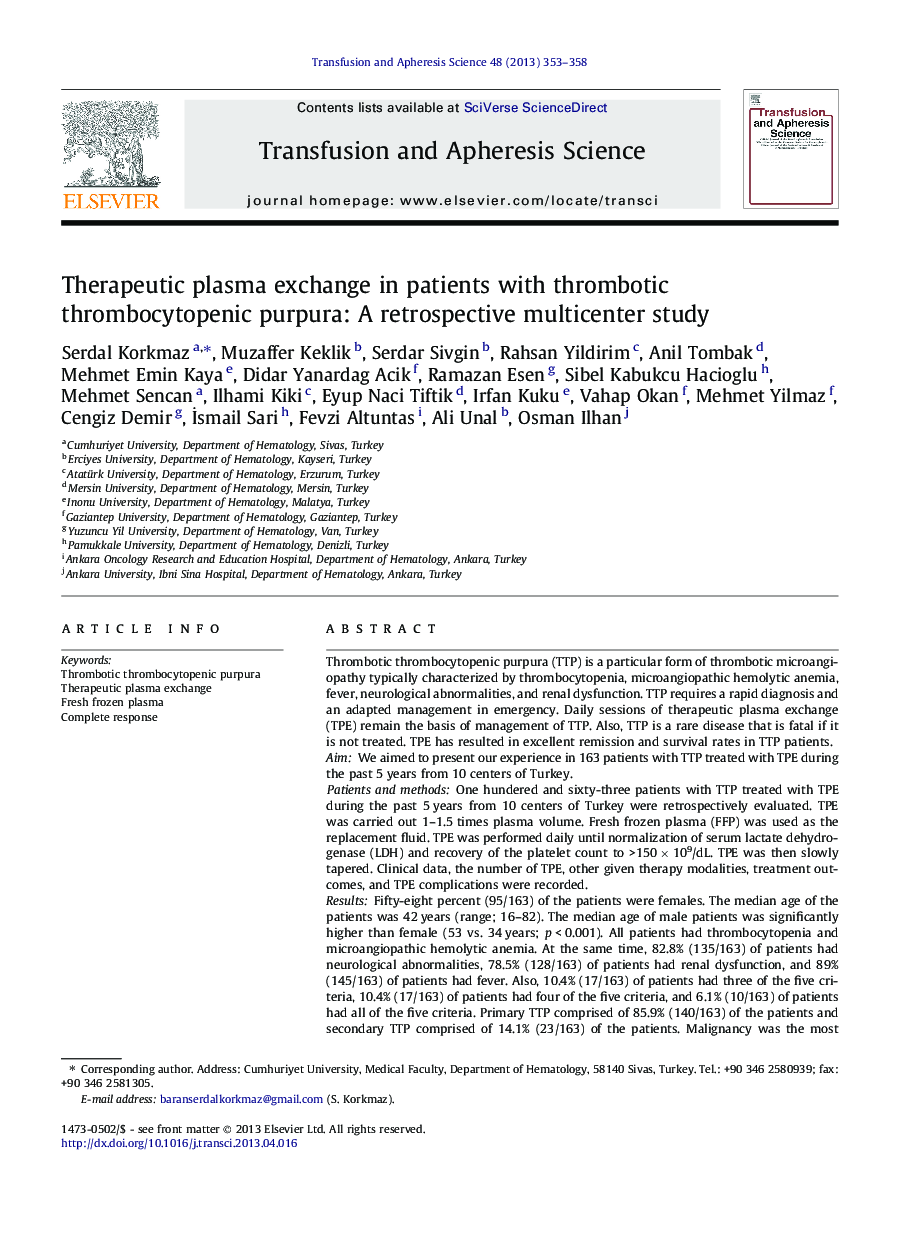| Article ID | Journal | Published Year | Pages | File Type |
|---|---|---|---|---|
| 3335194 | Transfusion and Apheresis Science | 2013 | 6 Pages |
Thrombotic thrombocytopenic purpura (TTP) is a particular form of thrombotic microangiopathy typically characterized by thrombocytopenia, microangiopathic hemolytic anemia, fever, neurological abnormalities, and renal dysfunction. TTP requires a rapid diagnosis and an adapted management in emergency. Daily sessions of therapeutic plasma exchange (TPE) remain the basis of management of TTP. Also, TTP is a rare disease that is fatal if it is not treated. TPE has resulted in excellent remission and survival rates in TTP patients.AimWe aimed to present our experience in 163 patients with TTP treated with TPE during the past 5 years from 10 centers of Turkey.Patients and methodsOne hundered and sixty-three patients with TTP treated with TPE during the past 5 years from 10 centers of Turkey were retrospectively evaluated. TPE was carried out 1–1.5 times plasma volume. Fresh frozen plasma (FFP) was used as the replacement fluid. TPE was performed daily until normalization of serum lactate dehydrogenase (LDH) and recovery of the platelet count to >150 × 109/dL. TPE was then slowly tapered. Clinical data, the number of TPE, other given therapy modalities, treatment outcomes, and TPE complications were recorded.ResultsFifty-eight percent (95/163) of the patients were females. The median age of the patients was 42 years (range; 16–82). The median age of male patients was significantly higher than female (53 vs. 34 years; p < 0.001). All patients had thrombocytopenia and microangiopathic hemolytic anemia. At the same time, 82.8% (135/163) of patients had neurological abnormalities, 78.5% (128/163) of patients had renal dysfunction, and 89% (145/163) of patients had fever. Also, 10.4% (17/163) of patients had three of the five criteria, 10.4% (17/163) of patients had four of the five criteria, and 6.1% (10/163) of patients had all of the five criteria. Primary TTP comprised of 85.9% (140/163) of the patients and secondary TTP comprised of 14.1% (23/163) of the patients. Malignancy was the most common cause in secondary TTP. The median number of TPE was 13 (range; 1–80). The number of TPE was significantly higher in complete response (CR) patients (median 15.0 vs. 3.5; p < 0.001). CR was achieved in 85.3% (139/163) of the patients. Similar results were achieved with TPE in both primary and secondary TTP (85% vs. 87%, respectively; p = 0.806). There was no advantage of TPE + prednisolone compared to TPE alone in terms of CR rates (82.1% vs. 76.7%; p = 0.746). CR was not achieved in 14.7% (24/163) of the patients and these patients died of TTP related causes. There were no statistical differences in terms of mortality rate between patients with secondary and primary TTP [15% (21/140) vs. 13% (3/23); p = 0.806]. But, we obtained significant statistical differences in terms of mortality rate between patients on TPE alone and TPE + prednisolone [14% (12/86) vs. 3% (2/67), p < 0.001].ConclusionsTPE is an effective treatment for TTP and is associated with high CR rate in both primary and secondary TTP. Thrombocytopenia together with microangiopathic hemolytic anemia is mandatory for the diagnosis of TTP and if these two criteria met in a patient, TPE should be performed immediately.
